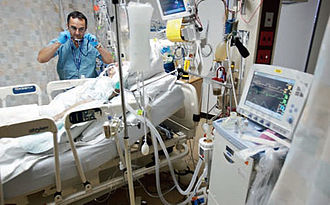“Baby at Play,” by Thomas Eakins (1876).
Win Whitcomb, M.D., writing in Hospitals & Health Networks, presents what he calls five “building blocks of success” in bundled payments. He is chief medical officer at Remedy Partners, in Darien, Conn.; an assistant professor of medicine at the University of Massachusetts Medical School, and a founder and a past president of the Society of Hospital Medicine.
Here are his building blocks, in abbreviated form:
1. Data
“For the first time, we are able to view cost data over the entire span of an episode, including acute care and the post-acute recovery period… Administrators and clinicians can identify variation in costs or quality, analyze processes underlying the variation and then implement new processes designed to mitigate such variation.”
“In addition, information systems are emerging that provide access to a patient’s location and clinical status over the entire course of an episode (something most electronic health records cannot do).”
2. Incentives
“Bundled payments disrupt the fee-for-service incentive to increase utilization. Medicare’s Bundled Payments for Care Improvement program enables hospitals, physician groups, post-acute facilities and home health agencies to bear first-dollar risk for an episode. The risk-bearing entity’s monetary reward for lowering costs can be invested in human resources (e.g., patient navigators) and technological resources (e.g., performance reporting and patient tracking software) that help the program succeed.”
“Gainsharing, most often offered to physicians, but also possible with hospitals, nursing facilities and other providers, can ensure that the risk-bearing entity and physicians or other providers have the same goal. Gainsharing in these programs can reward either internal cost savings (derived from, for example, bulk purchasing of implantable devices) or the net payment reconciliation amount (derived from, for example, lower post-acute facility utilization or fewer readmissions).”
3. Post-acute performance networks
“Successful risk-bearing entities build networks of post-acute facilities and home health agencies to ensure efficient and high-quality care for patients after an episode. Inclusion in such a network can be based on costs, readmissions or quality — such as star ratings, the availability of on-site providers and disease specialty programs. ”
4. Care redesign
“CMS promotes care redesign, or improving quality while cutting costs, as the defining feature of bundled payments. Successful organizations have redesigned care for specific bundles like joint replacement; others have redesigned care in an across-the-board fashion agnostic to bundle type.”
“Examples of across-the-board care redesign include deploying an early mobility program, using a decision-support tool to determine an optimal post-discharge location, applying rules to identify candidates for palliative care, having a structured goals-of-care conversation or using protocols to avoid unnecessary acute care transfers of skilled nursing patients. ”
5. Pooling knowledge
“BPCI supports the role of a ‘convener,’ working with ‘episode initiators’ (providers) to deploy the program. Conveners can provide crucial support for healthcare organizations that aren’t able to go it alone because of a shortage of resources or expertise in data analytics, information technology, care redesign and, in some cases, the assumption of a portion of financial risk.”
To read more, please hit this link.






